Tags
bargaining, humor, India, Indian food, kindness, Taj Mahal, temples, trains, travel
The Taj Mahal is very clean today
I am not a sharer. My dog is never allowed in my bed, my books never leave my house, and I never ever stay in a hotel room with those I haven’t wed or given birth to—and sometimes, not even with them. So I was worried about how sharing hotel rooms for several weeks with my two roommates from University days would work. Answer: amazing. Apparently, a lifetime of responsible jobs, marriages, and kids can evaporate in an instant when someone says, “Hey, remember the time we couldn’t find our exit tickets and had to jump the turnstiles at 57th Street?”
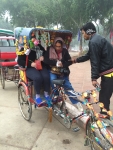
 After the first night’s room share, we got up early to stuff ourselves at the breakfast buffet get an early start for the Taj Mahal visit. While we said goodbye to the lovely food staff at the Taj Villas, our driver, Suhinder, brought the car around for the approximately one block drive to the parking lot for the Taj Mahal. After fending off a determined army of “official” guide/carved stone pregnant elephant vendors, we decided to take their advice and hire bicycle rickshaws. The theory was that they could get us to the Taj Mahal ticket booth quickly, in order to beat the crowds they assured us were about to descend. Our rickshaw pedalers set off with mighty determination, pulled out of the parking lot—and turned into the ticket office. Right next door. As usual, the tickets for foreign guests were about ten times the price of those for residents of India. But they did come with bottled mineral water and a “preferred” guest pass. Then, after we refused the services of about a thousand guides—official, Madam, very official—we arrived at the gorgeous Taj Mahal gates.
After the first night’s room share, we got up early to stuff ourselves at the breakfast buffet get an early start for the Taj Mahal visit. While we said goodbye to the lovely food staff at the Taj Villas, our driver, Suhinder, brought the car around for the approximately one block drive to the parking lot for the Taj Mahal. After fending off a determined army of “official” guide/carved stone pregnant elephant vendors, we decided to take their advice and hire bicycle rickshaws. The theory was that they could get us to the Taj Mahal ticket booth quickly, in order to beat the crowds they assured us were about to descend. Our rickshaw pedalers set off with mighty determination, pulled out of the parking lot—and turned into the ticket office. Right next door. As usual, the tickets for foreign guests were about ten times the price of those for residents of India. But they did come with bottled mineral water and a “preferred” guest pass. Then, after we refused the services of about a thousand guides—official, Madam, very official—we arrived at the gorgeous Taj Mahal gates.
We passed through the darkened doorway just as the sun was rising. And there it was. The Taj Mahal, misty and heartbreakingly beautiful. Whether you see it as a monument to the seventeenth century love story of Emperor Shah Jahan and his (favorite) wife, Mumtaz Mahal, or as the embodiment of Mughal power and wealth, the symmetry and artistic vision is stunning. In fact, the only break in the absolute symmetry of the entire structure is the emperor’s tomb, added beside that of his wife when he died. Others have tried to describe the Taj Mahal, but it’s one of the few things that can only be experienced in person.
And it turns out that we saw it at its best. Because President Obama was expected the next day, a massive cleanup force had descended on the monument. Roads leading up to the site had been cleaned, and beggars and dogs removed. (Still a lot of cows, though.) Inside, groups of women were working on the plantings by cleaning the edges of each bed with what looked like spoons. Seriously: spoons. [note: Sadly, Obama actually didn’t make it due to the state funeral for Saudi King Abdullah. I feel very sorry for him. Those spoon ladies did an amazing job.] The fountains and pools were immaculate, and beautiful birds were flitting around and singing. The sun came through the mist and turned the marble a softly glowing pink.
We spent the morning wandering through the monument and surrounding buildings and gardens. By the time we left, the hordes predicted by the rickshaw drivers had started to arrive by busload. Everyone seemed to be captured by the spirit of the Taj, as strangers from all over the world happily traded off taking pictures for each other.
It was so hard to leave, but we were on a strict feeding tour schedule, so we headed back to Suhinder waiting with the car for the three-hour drive to Delhi. Since we hadn’t eaten in minutes, we stopped on the way out of Agra at a roadside open-air restaurant and changed my world. Along with the chai tea, they brought us the ultimate paratha, the food of the gods. With butter. For the rest of the trip, I measured time as before parathas, during parathas, or after parathas.
Bargaining in India: beware of the chair and the special suitcase
We arrived in Delhi and checked into our guesthouse, arranged for us by one of Jaya’s work colleagues. This is another example of why you should only go to India if you also have a lifelong Indian friend with an enormous family and tons of contacts. The place was in the heart of Delhi, and came with watchmen and several cooks who asked us what we wanted for each meal. The only time they seemed upset with us was when we had to admit we couldn’t stuff in one more bite of their wonderful cauliflower curry, carrot curry, dal, homemade curds, rice, and fresh phulka (puffed chapati), etc. But we had to be strong because there was shopping to be done.
We staggered away from the table and back to the car for the ride to Dilli Haat. This is one of the treasures of India, a huge marketplace of stalls sponsored by the Indian government. Artisans from across the country are invited to set up shops for only fifteen days each, so visitors can see living crafts that span the diverse richness of India.
And sample we did. For those who are planning a trip to India, here are a few simple rules for shopping.
- Like everything in India, there are no rules. Only guidelines.
- The “price”, “final price”, and “final, final price” are just points on an infinite spectrum of possibilities. As far as I can tell, there is no such thing as the last two; there is just a point where buyer and seller get tired of bargaining.
- Don’t sit down. Once you’ve accepted the politely proffered seat which even the tiniest booth will magically produce, they own you—body, and wallet. (And if you let them give you tea, they might own your soul too.)
- Beware the Special Suitcase. Because the vendor recognizes your innate taste, discernment—and disposable income—he will pull out a suitcase of extra special items. Just to show you, Madam. No need to buy, but no cost for looking, right Madam? Obviously, you’ll already be sitting down (see #3), so you’ll find yourself helplessly admiring the miracles pulled from the special suitcase. Every item in the case is made, if not by his own family, then by his relatives. The price? Normally, you are assured, these would be double his price anywhere else. But because you’re the first sale of the day/last day he’ll be there/it’s a day of the week ending in the letter Y, he has a special price for you, a tragic level of loss for him and his family, but tribute to your unique status. Or maybe you’d like two of them for even less?
The first time I sat down, the special suitcase produced pashmina shawls, made from baby goats and woven so delicately, the entire shawl could be pulled through the seller’s ring. But, for Madam, there was one made from just the virgin beard of baby goats. It would resist wrinkles, was fireproof, and would keep me warmer than the warmest coat. Probably it could also leap tall buildings with a single bound.
Do you think I fell for such obvious sale hype? I’ve worn my Baby Goat Beard every day since.
Tomorrow: The Happiest Temple On Earth.



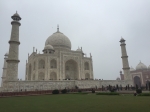
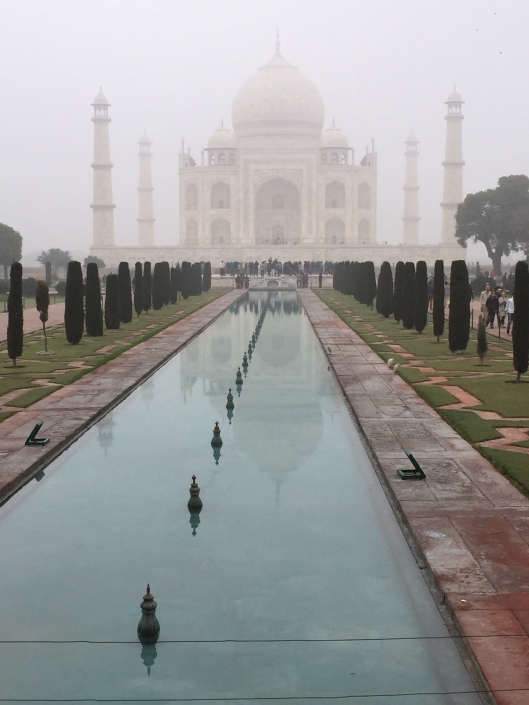


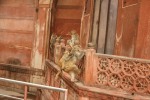
![Roadside parathas. With butter. [moan]](https://barbtaub.com/wp-content/uploads/2015/02/buttered-paratha.jpg?w=150&h=111)
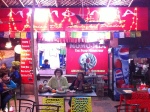
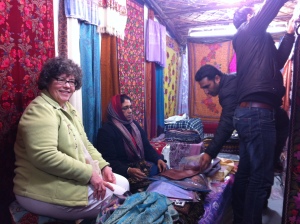
…great post, m’Lady, Barb… you gonna make a travelogue publishing piece ?
LikeLiked by 1 person
That sounds fun! Especially when I get to the parts involving medical intervention…
LikeLike
Absolutely loving these posts. Great stuff. 🙂
LikeLiked by 1 person
Thanks so much!
LikeLike
…both you and good pal, Sue Vincent, are terrific at capturing your travel stories :):)
LikeLiked by 1 person
I LOVE Sue’s posts, plus she’s an incredible photographer.
I’m very sorry to say, but we stumbled onto a “panorama” feature on our cellphone cameras. About a thousand bad panoramas later—including the bathroom—we made a sign for ourselves “Stop me before I pano again.”
LikeLike
I am thoroughly enjoying your trip Barb – thank you so very much!
LikeLiked by 1 person
Thanks so much, Paul!
LikeLike
Taj Mahal did seem very clean on that day for your visit!
LikeLiked by 1 person
I felt so bad because everyone was super excited about Obama’s visit. Hope he makes it there eventually.
LikeLike
Great story! But, I remember sharing a sketchy hotel room with you on your bride-groom-less honeymoon with a chair propped under a rickety door, a storm wailing outside, and you saying “this would be FUN if Bart were here”!
LikeLiked by 1 person
Well, sure…all honeymoons are improved by the presence of your groom instead of your sister.
LikeLike
It is an excellent post indeed! You got to the heart of the matter where shopping was concerned! Loved the way you have expressed your view and my country. 🙂
LikeLiked by 1 person
Thank you so much! I’m delighted to hear that you liked the post. Since moving to Glasgow last year, I’ve been taking a poll of taxi drivers. So far, 100% of them replied to my question of whether they’ve been to the States by assuring me that they have indeed been to Orlando’s Disney World. So in that spirit, I can’t say that I’ve done any more than scratch the surface of India. But even so, it was the most amazing, eye-opening trip I’ve ever taken. (And that’s not even counting the parathas!)
LikeLiked by 1 person
Great post! Sounds like you had fantastic time. Looking forward to more travelogues soon!
LikeLiked by 1 person
It’s been an absolutely fantastic trip for the most part. (And for the rest… well, I can’t be the first one to say “Sure, I’ll go to the hospital. Just think of the blog I can write!)
LikeLiked by 1 person
So jealous you saw the Taj Mahal. It’s still amazing looking. Maybe one day I will see it in person. Great trip report!
LikeLiked by 1 person
You’ve just GOT to go to India. Along with the Taj, just think of all the restaurants you could try!
LikeLike
Very envious of your trip to the Taj Mahal Barb but less so with the general exhaustion of fending off all the enthusiasts wanting to sell you stuff or ‘guide’ you. Am loving coming along on your trip though – brilliant! So thanks for sharing 🙂
LikeLiked by 1 person
You’re right about the trip being brilliant! And—except when it involves children—I’m okay with the “entrepreneurs”—they are polite, often witty, and usually entertaining. (Of course, we have Jaya along to run interference, so that might make all the difference.)
LikeLiked by 1 person
Loving following your India trip – thanks for really great reading!
LikeLike
Wow just catching up, and I’m so envious. Great photos and posts. What a place.
LikeLike
I’m enjoying your vacation immensely. Especially today’s shopping tips.
LikeLike
I doubt I could take the strain of too much bargaining. I had a hard enough time in Singapore and could stick with the tamed, westerner-friendly environs there.
LikeLike
Pingback: What I did on my excellent India vacation—Part 5. | Barb Taub
Pingback: What I did on my excellent India vacation—Part 6. | Barb Taub
Pingback: What I did on my excellent India vacation—Part 7. | Barb Taub
Pingback: What I did on my excellent India vacation—Part 8. | Barb Taub
Pingback: What I did on my excellent India vacation—Part 9: Delhi Belly | Barb Taub
Pingback: What I did on my excellent India vacation—Part 10: Cars, Trains, and… Auto-Rickshaws | Barb Taub
Pingback: What I did on my excellent India vacation—Part 11: Goodbye Mumbai! Now I just have to figure out who to kill… | Barb Taub